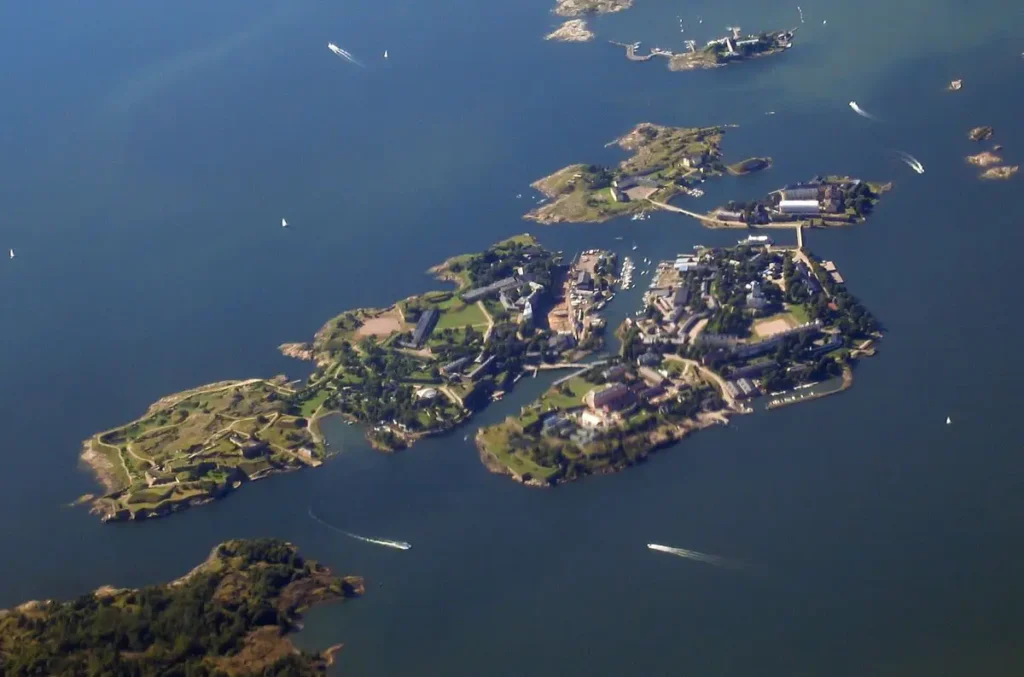
Suomenlinna Fortress, located on an island just off the coast of Helsinki, is a UNESCO World Heritage Site and one of Finland’s most significant historical landmarks. Originally built in the 18th century as a defensive fortress, it has evolved over time into a cultural hub, featuring historical architecture, museums, and a vibrant community.
Visitors can explore the fortress through a variety of museums, such as the Suomenlinna Museum and the Ehrensvärd Museum, which offer deep dives into its military history and its role in Finnish heritage. The fortress also features other attractions like the Submarine Vesikko and several historical buildings, including the Suomenlinna Church and King’s Gate.
The site is well-known for its scenic beauty, with walking trails that pass through lush landscapes and offer stunning views of the Baltic Sea. The fortress is also accessible by a short ferry ride from Helsinki, taking about 15-20 minutes.
If you’re planning a visit, it’s recommended to set aside at least three hours to explore the island, and wear comfortable shoes due to the uneven terrain. Guided tours are available for a more in-depth experience, and you can also bring a picnic to enjoy while watching the beautiful sunset.
Suomenlinna is not only a must-see for history enthusiasts but also offers an exceptional experience for nature lovers and those seeking a peaceful escape from the city.
Exploring the History of Suomenlinna Fortress

Origins and Construction
Suomenlinna Fortress, originally known as Sveaborg, was established by Sweden in the mid-18th century as a defense against Russian expansion. Construction began in 1748 under Swedish naval officer Augustin Ehrensvärd. The fortress was strategically placed on several islands off Helsinki, providing natural defenses and a crucial control point for sea traffic in the Baltic. It was one of the largest maritime fortresses of its time, with six major sea forts, tunnels, and ramparts interconnected across the islands.
Shifting Tides of Power
In 1808, following Sweden’s defeat in the Finnish War, Finland was ceded to Russia. Sveaborg became a key Russian military base and was renamed Viapori. During this period, the fortress was expanded and modernized. However, during the Crimean War (1853-1856), a British-French naval bombardment revealed its vulnerabilities. Despite being heavily fortified, the fortress struggled to withstand modern artillery, exposing gaps in its defenses.
A Return to Finnish Control
After Finland gained independence from Russia in 1917, Viapori was handed over to Finland and renamed Suomenlinna, meaning “Castle of Finland.” Although the fortress continued to serve military functions, its importance declined with the establishment of Finland’s independent defense infrastructure.
Transformation into a Cultural Hub
In the 1970s, the Finnish military ceased operations at Suomenlinna, and the fortress was opened to the public. Former military structures were repurposed into museums, art galleries, cafes, and restaurants, making the fortress a cultural and tourist destination. In 1991, it was designated a UNESCO World Heritage Site, solidifying its historical and architectural significance. Today, Suomenlinna is one of Finland’s most iconic landmarks, offering visitors a captivating journey through the country’s history while showcasing its cultural evolution.
Architectural Marvels of Suomenlinna

Layout and Design
Suomenlinna Fortress’s design is a remarkable example of military architecture, emphasizing defensive strength while blending with the natural landscape. The layout includes star-shaped ramparts, bastions, and walls strategically positioned to fend off attacks. This structure, designed to withstand artillery bombardments, reflects the military foresight of its builders. Its innovative design allowed for controlled fire and defense against sea attacks from multiple directions.
Defensive Structures
Among the key defensive features of Suomenlinna are the King’s Gate and Great Courtyard. The King’s Gate, dating back to the 18th century, remains one of the most iconic entrances to the fortress, offering a grand welcome to visitors. It also symbolizes the fortress’s original strength and importance as a military stronghold. The Great Courtyard is a central area where the fortress’s primary defensive walls converge, further underscoring the strategic positioning of the entire complex.
Iconic Features
Suomenlinna is home to several iconic landmarks that add to its architectural and cultural significance. The Suomenlinna Church, originally built as a Russian Orthodox church in 1854, now serves as a Lutheran church and a prominent symbol of Finnish heritage. Another standout feature is the Jetty Barracks, which were used by the military and now house museums, cafés, and galleries. These landmarks are not just functional but are integral to the fortress’s character, providing insight into its evolution from a military stronghold to a UNESCO World Heritage site.
The fortress’s unique architecture, combined with its strategic location, continues to fascinate visitors and historians alike, making Suomenlinna one of Finland’s most cherished landmarks.

Cultural and Tourist Attractions
Suomenlinna is not only a historical landmark but also a hub of cultural activities and attractions. Visitors can immerse themselves in the fortress’s rich history through several museums, including the Suomenlinna Museum and the Ehrensvärd Museum. These institutions provide valuable insights into the fortress’s military significance and the life of its founder, Augustin Ehrensvärd.
The fortress is also home to various art galleries and studios, where both historical and contemporary Finnish art is showcased. Visitors can enjoy the vibrant art scene that makes Suomenlinna a cultural destination. Moreover, the island hosts numerous festivals and events throughout the year, such as music concerts, theater performances, and outdoor markets, making it a lively place for both tourists and locals.

Visitor Information
To reach Suomenlinna Fortress, visitors can take a short ferry ride from Helsinki’s Market Square. The journey, which lasts around 15 minutes, is convenient and operates daily throughout the year. Tickets for the ferry can be purchased at the terminal or via the HSL app. Additionally, water buses run between May and September, providing a scenic alternative.
Upon arrival, visitors can explore the fortress at their own pace. The island offers several amenities, including cafes, restaurants, and souvenir shops. For those looking for more guidance, audio guides and information signs are available, providing details on the fortress’s history and its key attractions

Preservation Efforts
Preserving the cultural and natural heritage of Suomenlinna is a priority for Finnish authorities. Ongoing conservation efforts include restoration projects and archaeological research to maintain the site’s historical structures and environment. The fortress’s strategic location and its role in Finnish identity make it a vital part of the nation’s heritage, and its management is closely overseen by the governing body under Finland’s Ministry of Education and Culture.
Despite challenges like climate change and growing tourism, the preservation initiatives aim to safeguard both its architecture and the surrounding natural landscape. This includes ensuring sustainable tourism practices while preserving the site’s integrity. The ongoing efforts are supported by a management plan designed to keep the fortress functional for future generations.
As one of Finland’s most visited destinations, Suomenlinna’s future is secure with continued investment in its protection, ensuring that it remains a symbol of national pride and a cultural landmark.
Local Cuisine and Dining Options
Suomenlinna offers visitors a variety of dining options, allowing them to enjoy traditional Finnish cuisine in a picturesque setting. Some of the best places to eat on the island include:
- Café Piper: One of the oldest cafes on the island, dating back to the 1920s. It offers light lunches, salads, pastries, and drinks in a peaceful garden setting with sea views.
- Restaurant Suomenlinna Brewery (Panimo): Known for its modern twist on traditional Finnish dishes and an on-site microbrewery offering craft beers.
- Café Vanille: A charming spot for homemade cakes, pies, and sandwiches, with vegan and gluten-free options available.
- Walhalla Restaurant: A fine-dining option offering seafood and seasonal dishes, with stunning views of the sea near King’s Gate.
For a more relaxed meal, visitors can also enjoy picnicking in designated areas like Kustaanmiekka and Piper’s Park, where they can enjoy panoramic views and lush greenery.
To try local specialties, don’t miss dishes like Lohikeitto (salmon soup), Karjalanpiirakka (Karelian pies), and Korvapuusti (cinnamon buns), which are staples of Finnish cuisine
FAQ
1. How do I get to Suomenlinna?
Suomenlinna is easily accessible by ferry from Helsinki’s Market Square. The ferry ride takes around 15 minutes. During the summer season, there are additional water bus connections from Market Square to Lonna Island via Suomenlinna.
2. What are the opening hours of Suomenlinna?
Suomenlinna is open year-round, with varying operating hours depending on the season. Public transport ferries run daily, while special ferries may operate on weekdays.
3. Is there an entrance fee to visit Suomenlinna?
While entry to the fortress itself is free, some museums and guided tours inside the fortress may require a ticket.
4. What can I do on Suomenlinna Island?
Suomenlinna offers a mix of history, culture, and outdoor activities. Visitors can explore military structures, museums, art galleries, and enjoy scenic walks, picnics, or even swimming in the surrounding waters.
5. Is there food available on the island?
Yes, Suomenlinna features a number of cafes and restaurants offering traditional Finnish dishes and local delicacies.
6. Are there guided tours available?
Yes, guided tours are available in multiple languages, and visitors can book private tours in advance or join public ones listed in the events calendar.





